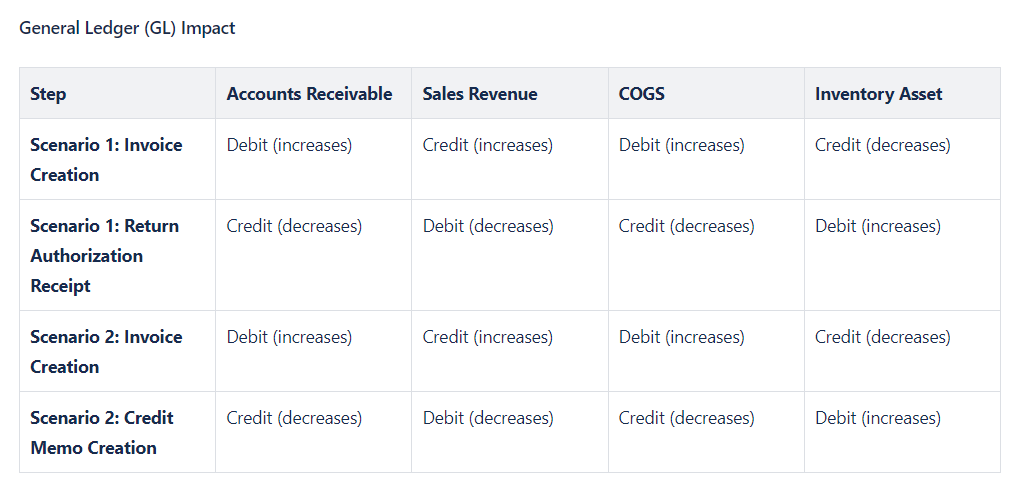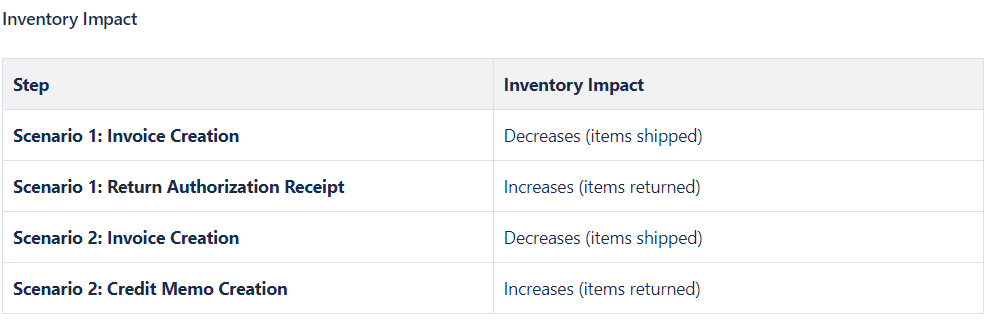G/L impact of creating Credit memos from Invoices, I’ve added a detailed report below. Please review and verify.
Detailed Report on GL and Inventory Impact in NetSuite
Scenario 1: Create an Invoice from the Sales Order and then Return it Using the Return Authorization
Step 1: Create an Invoice from the Sales Order
- Sales Order Creation:
- Impact on Inventory: No immediate impact. Inventory is committed but not yet reduced.
- Impact on GL: No impact as inventory is not yet fulfilled.
- Invoice Creation:
- Impact on Inventory: Inventory is reduced as items are shipped.
- Impact on GL:
- Accounts Receivable: Debit (increases)
- Sales Revenue: Credit (increases)
- Cost of Goods Sold (COGS): Debit (increases)
- Inventory Asset: Credit (decreases)
Step 2: Create a Return Authorization
- Return Authorization Creation:
- Impact on Inventory: No immediate impact. Inventory is expected to be returned.
- Impact on GL: No impact until items are received.
- Item Receipt for Return Authorization:
- Impact on Inventory: Inventory is increased as returned items are received.
- Impact on GL:
- Accounts Receivable: Credit (decreases, if refund is issued)
- Sales Revenue: Debit (decreases, reverses the sale)
- Inventory Asset: Debit (increases)
- Cost of Goods Sold (COGS): Credit (decreases)
Scenario 2: Create an Invoice from the Sales Order and then Create a Credit Memo
Step 1: Create an Invoice from the Sales Order
- Sales Order Creation:
- Impact on Inventory: No immediate impact. Inventory is committed but not yet reduced.
- Impact on GL: No impact as inventory is not yet fulfilled.
- Invoice Creation:
- Impact on Inventory: Inventory is reduced as items are shipped.
- Impact on GL:
- Accounts Receivable: Debit (increases)
- Sales Revenue: Credit (increases)
- Cost of Goods Sold (COGS): Debit (increases)
- Inventory Asset: Credit (decreases)
Step 2: Create a Credit Memo
- Credit Memo Creation:
- Impact on Inventory: Inventory is increased as items are returned.
- Impact on GL:
- Accounts Receivable: Credit (decreases)
- Sales Revenue: Debit (decreases)
- Cost of Goods Sold (COGS): Credit (decreases)
- Inventory Asset: Debit (increases)

- Scenario 1:
- Creating an invoice from the sales order affects both inventory and GL accounts initially. Upon return authorization and item receipt, these impacts are reversed.
- Inventory: Decreases when items are shipped, increases when items are returned.
- GL: Accounts Receivable and Sales Revenue increase initially, then decrease upon return. COGS increases initially, then decreases upon return.
- Scenario 2:
- Creating an invoice from the sales order affects both inventory and GL accounts initially. Creating a credit memo reverses both GL and inventory impacts.
- Inventory: Decreases when items are shipped, increases when items are returned.
- GL: Accounts Receivable and Sales Revenue increase initially, then decrease with the credit memo. COGS increases initially, then decreases with the credit memo. Inventory Asset decreases initially, then increases with the credit memo.
